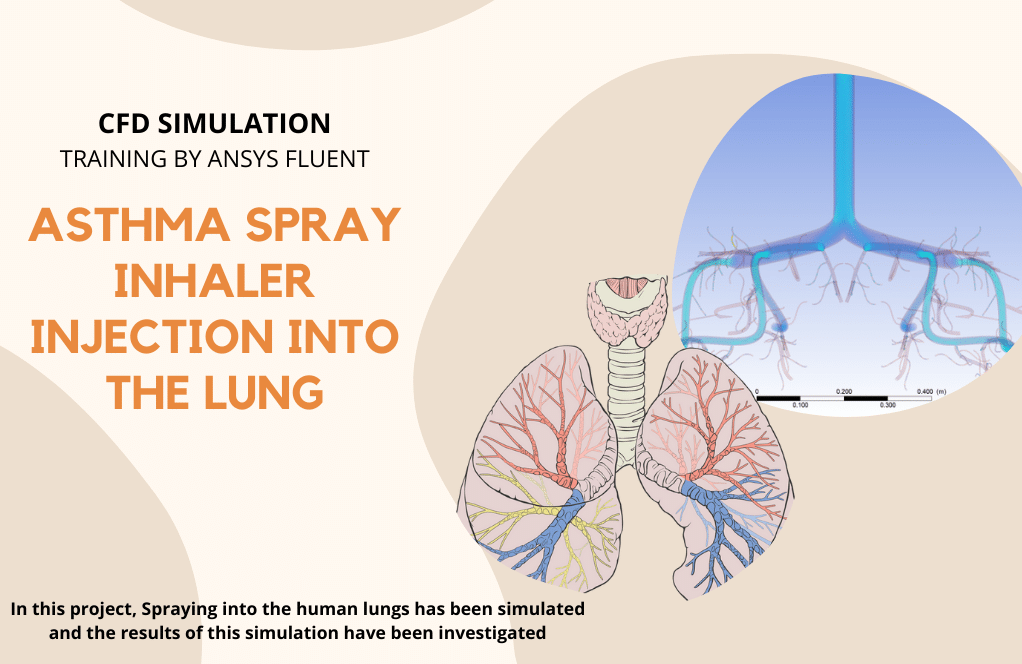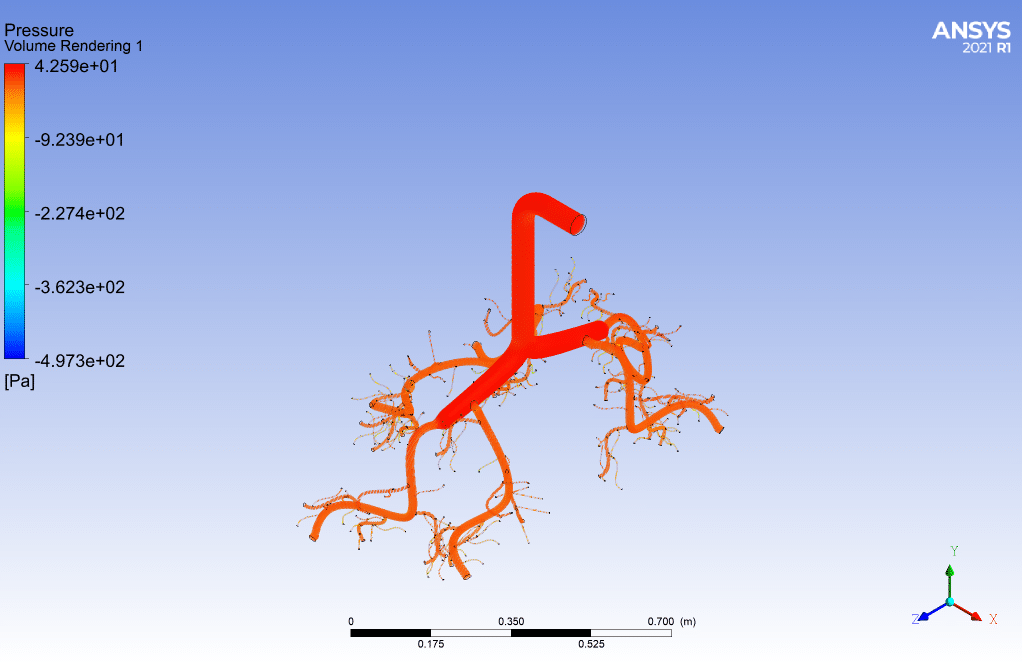Asthma Spray Inhaler Injection Into the Lung, Ansys Fluent Training
$80.00 $40.00 Student Discount
- The problem numerically simulates Asthma Spray Inhaler Injection Into the Lung using ANSYS Fluent software.
- We design the 3-D model by the Design Modeler software.
- We Mesh the model by ANSYS Meshing software, and the element number equals 3734234.
- We perform this simulation as unsteady (Transient).
- We use the Discrete Phase Model (DPM) to define Asthma spray injection into the lung.
Click on Add To Cart and obtain the Geometry file, Mesh file, and a Comprehensive ANSYS Fluent Training Video.
To Order Your Project or benefit from a CFD consultation, contact our experts via email (info@mr-cfd.com), online support tab, or WhatsApp at +44 7443 197273.
There are some Free Products to check our service quality.
If you want the training video in another language instead of English, ask it via info@mr-cfd.com after you buy the product.
Description
Description
The present problem simulates asthma Spray into the human lungs using ANSYS Fluent software. We perform this CFD project and investigate it by CFD analysis.
The present model is designed in three dimensions using the SpaceClaim software. The geometry of the present model consists of a simple human lung model, and the inlet diameter of the lung is 50cm.
The meshing of the model was done using ANSYS Meshing software. The element number is 3734238.
Also, due to the nature of the problem, the transient solver is enabled.
Asthma Spray Methodology
In this study, Asthma Spray in human lungs was investigated using the one-way DPM (Discrete phase material) method using Ansys Fluent software.
In this simulation, two types of material are used: air and particles that enter the lungs in a Discrete phase material. Trajectories of particles within the lung were observed using Ansys Fluent software.
The air inlet velocity enters the field at 5 m/s with a gravity of -9.81 m/s2 on the z-axis. Also, the particles with a diameter of 100 microns enter the domain using a surface velocity injection. Moreover, the realizable k-epsilon model is used to solve turbulent fluid equations.
Asthma Spray Conclusion
After the solution process is completed, two and three-dimensional contours of velocity and pressure are obtained. In addition, in the extracted animation, we may see the Particle tracks in the lungs.












Mrs. Jolie Balistreri II –
This CFD model sounds really detailed. I was curious to know how closely does the simple human lung model resemble the real human lung anatomy in terms of flow dynamics for the spray particle distribution?
MR CFD Support –
In the context of CFD simulations, a ‘simple human lung model’ is usually a simplification of the intricate anatomy of actual lungs, designed to capture the essential features affecting airflow and particle distribution. These models would typically account for the major branching patterns and airflow dynamics, allowing for the study of particle behavior such as that from an asthma inhaler. However, they may not capture all the complexities of real human lung anatomy. The resulting flow dynamics can then be considered representative for an overall understanding but would ideally be validated against more anatomically accurate models or experimental data for precise medical applications.
Susan Jacobson Jr. –
The process of creating this simulation is fascinating. I admire the complexity of the model and especially appreciate the attention to realism with the inclusion of factors like the gravity effect and accurate particle sizes. Well done!
MR CFD Support –
Thank you for your kind words! We’re glad you appreciate the intricacies of the model and the effort we put into ensuring it closely mimics real-world physics. Your feedback is invaluable to us.
Athena Simonis –
The training product for the asthma spray inhaler simulation seems interesting. How does the model take into account the complexity of human lung anatomy?
MR CFD Support –
In this training product, a simplified geometry of the human lung model is used to analyze the spray distribution. While it may not capture the full complexity of human lung anatomy, it incorporates enough detail to simulate the behavior of asthma spray particles as they enter and interact with the airflow within the lungs.
Prof. Virgil Hodkiewicz –
The spray methodology using DPM in ANSYS Fluent is fascinating. The simulation seems complex. How was it ensured that the spray particles accurately represented the properties of actual asthma inhaler medication particles?
MR CFD Support –
Admin carefully calibrated the particle properties in the DPM settings to match those of the real medication particles. Parameters such as particle density, diameter, and injection velocity were all set to mimic the physical behavior of the asthma inhaler’s spray as closely as possible.
Dr. Keagan Bogisich II –
The training was eye-opening in helping me understand how asthma inhalers disperse medication in the lungs. I saw particle tracks clearly, which gave me a much better understanding of aerosol dynamics.
MR CFD Support –
Thank you for your kind words! We’re glad to hear our training on Asthma Spray Inhaler Injection Into the Lung using ANSYS Fluent was educational and helped you visualise the medication dispersion process through aerosol dynamics. Your feedback is much appreciated, and we hope our training continues to provide valuable insights and learning experiences.
Miss Leta Adams –
Wow, the level of detail in the Asthma Spray Inhaler simulation is impressive! It must provide valuable insights into aerosol drug delivery.
MR CFD Support –
Thank you for your kind words! We’re delighted to hear you found the Asthma Spray Inhaler simulation detailed and useful. Such feedback is immensely appreciated and motivates us to keep delivering high-quality learning products.
Devyn Kreiger –
What is the advantage of using the realizable k-epsilon model in this asthma spray simulation?
MR CFD Support –
The advantage of using the realizable k-epsilon turbulence model in the asthma spray simulation is that it provides improved accuracy for flows involving separation and recirculation, which are typical in respiratory flow simulations. It helps in predicting the spread and deposition of the spray particles within the complex geometry of the human lungs.
Lydia West –
I’m truly amazed by the detail level of lung modeling—particularly how well it simulates the particle flow from the asthma spray. Thank you for this insightful training resource!
MR CFD Support –
Thank you for your kind words! We’re thrilled to hear you found the asthma spray simulation and training so valuable for understanding particle flow in the lungs. Your enjoyment and satisfaction with our course means a lot to us.
Morgan Hill –
Spectacular work in simulating the delivery of Asthma Spray into the lungs. It really helps in understanding the mechanism of inhalers and their effectiveness.
MR CFD Support –
Thank you for your kind words! We are delighted to hear that our simulation could enhance your understanding of asthma spray mechanisms. If you need any further information or have more queries about our simulations, feel free to reach out.
Kari Williamson –
I’m thrilled about the real-time application of this study. Could you tell me more about how the aerosol particles’ deposition in the lung is analyzed?
MR CFD Support –
In such simulations, the deposition of aerosol particles in the lungs is analyzed by tracking the particles’ trajectories using the Discrete Phase Model (DPM). Modeling factors like turbulent dispersion, variable lung geometry, and airflow rates enable us to see where and how particles deposit on the lung surface.
Estrella Stanton –
How does the inclusion of gravity affect the distribution of the asthma spray particles in the lung simulation?
MR CFD Support –
In the lung simulation, gravity affects the particle distribution by influencing the settlement and behavior of the asthma spray particles. Since the gravity vector is directed along the negative z-axis, it causes the particles to tend to move downwards. This is important to capture the realistic behavior of particles as they are influenced by gravity when a person uses an asthma inhaler in a real-life situation.
Tess Jakubowski –
I am very impressed with how effectively the Asthma Spray Inhaler Injection simulation illustrates the particle distribution in the lungs. This was enlightening and helped me understand the dynamics much better, thank you!
MR CFD Support –
We appreciate your positive feedback! We’re glad to know the simulation was insightful for you and that it clarified the particle dynamics within the lungs. If you have any more questions or require further assistance with our products, don’t hesitate to reach out. Thank you for choosing our training module!
Ansel Dare –
Is it possible to model different particle sizes in the simulation to see how smaller or larger particles would behave compared to the 100-micron reference used here?
MR CFD Support –
Absolutely, the simulation can model various particle sizes by adjusting the discrete phase model (DPM) settings. Changing particle diameters will show you how particle size influences deposition patterns and penetration depth within the lung’s anatomy.
Prof. Ceasar Farrell –
The Asthma Spray Inhaler Injection training was enlightening, showcasing detailed aerosol dynamics within a simplified lung model. The visualizations helped me understand how the spray behaves, which is crucial in medical applications!
MR CFD Support –
Thank you for your positive feedback! We’re delighted to hear that the training was helpful and that the visualizations aided your understanding of aerosol behavior in lung models. If you have any further questions or need more information, feel free to reach out!
Prof. Brenna Hamill –
I’m curious to know if the simulation captured any details regarding how effective the spray distribution was within the lungs. Did the results help in understanding how to improve asthma spray designs?
MR CFD Support –
The simulation does capture the spray distribution within the simplified lung model. It tracks the particles from the inhaler, allowing insights into how aerosol medications might be deposited throughout the lungs. The results contribute to a better understanding of inhaler design by showing areas where the particle concentration is higher or lower, which has implications for improving the design and efficiency of asthma sprays.
Leonel Feest –
Fantastic material and explanation! This project surely helps with understanding the delivery mechanics of asthma medications.
MR CFD Support –
Thank you so much for your positive feedback! We’re delighted to hear that our simulation project on Asthma Spray Inhaler Injection into the Lung was informative and helpful. We strive to provide comprehensive and practical educational material. Your satisfaction means a lot to us!
Prof. Tyree Gaylord –
I enjoyed going through the simulation for asthma sprays in human lungs, but was curious if this CFD analysis considers the transient breathing cycle of inhalation and exhalation or if it’s focused solely on the inhalation phase.
MR CFD Support –
The simulation primarily focuses on the inhalation phase where the aerosol medicine from an asthma spray is introduced into the lungs. The effects of the spray are analyzed using a transient CFD analysis to understand how the particles disperse. The interaction with a full breathing cycle is not explicitly mentioned, but the transient nature of the solver suggests a dynamic, time-dependent study of the inhalation phase.
Prof. Jasen Howell V –
This simulation sounds wonderful! Seeing the particle tracks must be impressive and undoubtedly enhances the understanding of asthma inhaler dispersal!
MR CFD Support –
Thank you for your kind words! We are delighted to know that our attention to detail in the simulation of the asthma spray dispersion has enhanced your understanding. It’s great to hear that our efforts to provide a clear visualization of particle tracks within the lung model have made a positive impact.